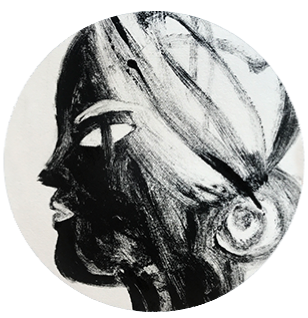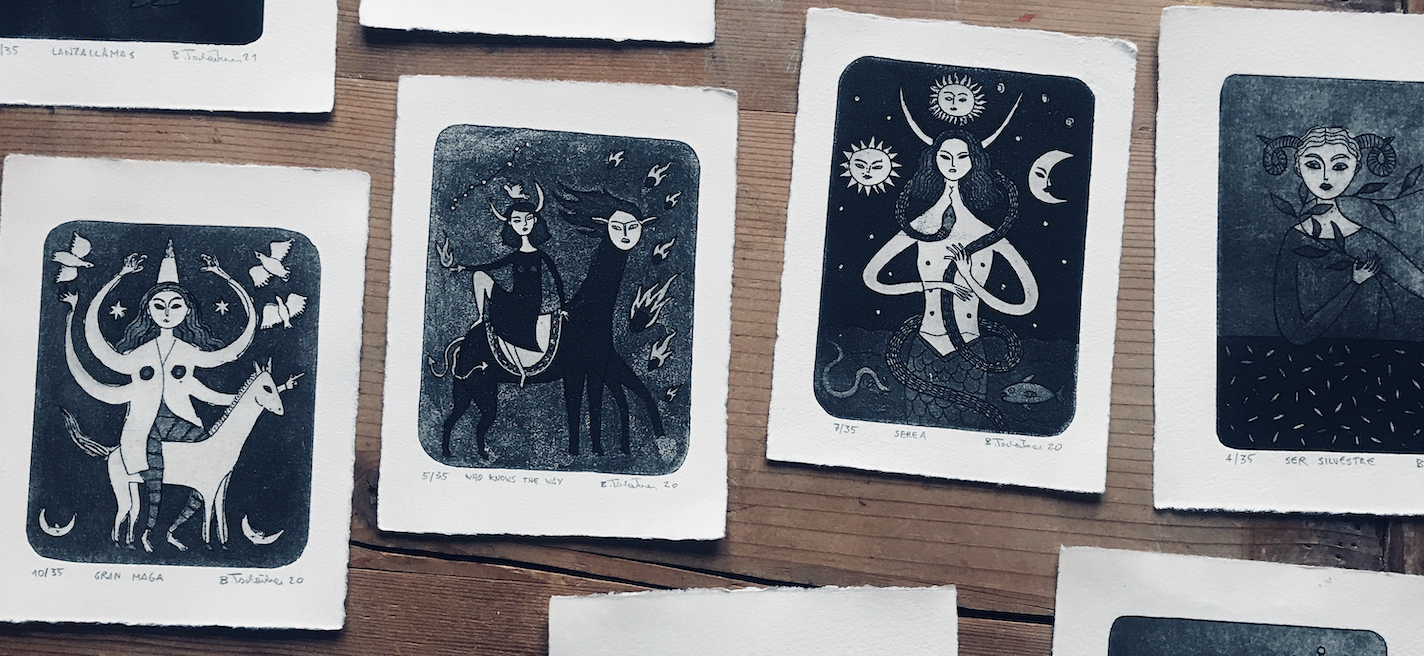In my work, there are many happy accidents, and this lithograph, which is called HAZE, is one of my favourite accidents. I actually was trained in lithography, but that was a long time ago, and when I started to work with it again many years later, I didn't have my notes from school with me, and I didn't remember the steps exactly – painting and printing on stone involves a rather complex chemical process in several steps.
So, I just started to experiment. Obviously, I did something wrong (and only afterward learned what it was: I used the wrong ink) and the image kept changing as I printed the edition, and the lady smoking a pipe was slowly shrouded in smoke. I wasn't exactly happy when I printed this but when I was done, I realized that I had printed something wonderful, something that I could have never conjured up. Instead of an edition of eight identical lithographs, of eight small artworks, I had one big artwork which was much more interesting. The accident had added another dimension to my artwork.
And this is the beauty of mistakes – they open doors and allow us to explore ways we would have never noticed. I wasn't born a perfectionist, but I was definitely raised to be one, just as it happens to many children. Perfectionism can have its good sides, but it also ruins a lot, especially if it is not in our nature, but something forced upon us. It makes us scared of the wonderful unknown, the magical things that happen when we surrender to the process and give up control, and not only give up the fear of failure but embrace it.
The opposite of perfectionism is not sloppiness or laziness. It's keeping ourselves open to all possibilities: It's to work how children work, not work, but play, not walking down a pre-defined road, but to roam, to explode, and not to be frustrated about mistakes, but to be curious about them, and often delighted.
It took me many years to lose my perfectionism and to stop bothering about mistakes, and start to see them as an invitation to new, unexpected things instead. In the beginning, it was not a conscious decision, not something I wanted to change about my work or something I wanted to teach myself. Because, of course, no perfectionist has the desire to be less perfect.
Instead, I was taught without asking for it, without knowing that I needed it. Printmaking taught me a lot about it, and also, on a deeper level, spending a long time in places on this earth where perfection and routine planning and controlling things did not matter as much as it matters where I was born, far away places where the streets are full of magic and life and where serendipity and wonder is weaved into the fabric of everyday life.
My work has improved greatly from these lessons, and it has humbled my ego: Because now I not only know, but I also feel that it is not only me who creates my artworks, but I'm collaborating with something else. I’m collaborating with chance, with my surroundings, with the unknown, with serendipity, with everything around me. I do my best, but only if I submit to these forces, which are bigger than me, I can use them in my work. And these are great gifts from which my work benefits enormously, because these are things I could never do from my through my own strength; nobody can.
Working like this feels good, and freeing. I now feel like I was when I was a small child, when I was still free, and I think about what Picasso said: "It took me four years to paint like Raphael, but a lifetime to paint like a child."
I also know that more and more children bear the burden of having to be perfect. I have experienced children drawing in my workshops with adults standing next to them, telling them what they painted wrong. It reminds me of when I was in kindergarten, having just discovered how checkered patterns work, which fascinated me enormously, and I started to experiment a lot with color overlays, until one day, when I decided to make a huge checkered pattern, filling the whole sheet of paper with it. When my kindergarten teacher saw this, she got angry and said: You are wasting the paper! Correct that and draw something properly! And so, I couldn’t finish my giant pattern and turned it into something I assumed the teacher deemed proper: a castle with princesses. I still have this drawing.
There is so much damage done to children, so for me, it has become important to antagonise this in my workshops consciously. I want to provide a space where children can retain their creative playfulness, and where adults can regain it. When I do workshops for children in my studio, I tell them: There is only one rule in the studio: There is no right or wrong (and keep your fingers away from the printmaking press when someone is printing :-D )
Today, I mostly work without the fear of failure and the pressure of being perfect. I still want to do work that is well done, but my brush now lies very loosely in my hands. There is just as much failure in my work as there was when I was a perfectionist, but the failure now is integrated into my work, and my work is only benefiting from it.
I work with curiosity now, not with pressure. Still (or even more than before, because now I work a lot with ceramics), there are many things in my work that don't go well, that don't look good, that have failed, ceramics that break or tear, that ultimately die. Mostly I just accept it and I don't care, sometimes it hurts, but not for long, I just move on. Because I now know that failures are necessary, just as in nature, where things are growing in abundance and without measure and where many things rot and die along the process, but they do not get lost, they remain part of the whole: They are the humus from which new things grow.


